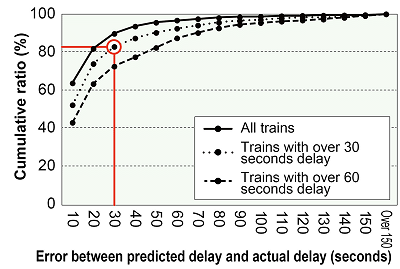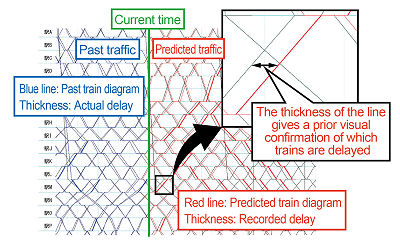23. Method for predicting train delay and train occupancy rate with a lead time of several tens of minutes
When train delays occur, train dispatchers predict changes in train delay and occupancy rates with a lead time of several tens of minutes, in order to arrange operations appropriately by adjusting train headways etc. Because these predictions rely on train dispatcher experience, it is not easy to rationalize their decisions. Although some operation control system contain a prediction function, the functions are based on the assumption that the conditions of train delay will continue. Accuracy therefore can be a problem.
In this research, a method based on neural network was developed to predict train delays and occupancy rates with a lead time of several tens of minutes. In the first stage of this method neural networks learn from data about train delays and occupancy rates recorded in the days leading up to when a prediction is made. On the day a prediction is made, with pre-trained neural networks, changes in train delay and occupancy rates up to the time in question are used to predict the situation for the next few tens of minutes.
A prototype system based on this method was built for testing on an actual commuter line, to verify the accuracy of the proposed method. 70 days of train delay and occupancy rate data was used for neural network learning, while data for a period of 9 days was used in the verification test. The result of the verification tests showed that, excluding data recorded when a sudden accident had occurred, the method could predict train delays to within 30 seconds in over 80% of predictions (Fig. 1).
In practice, the method would be applied to operation control systems in the control room. Predicted delays and occupancy rates could then be displayed in the operation control system (Fig. 2). Train dispatchers can check the predicted delay or occupancy rate from the display, and arrange operations appropriately. In addition, these predictions can be used to provide passengers with information about traffic conditions, because large delays and high occupancy rates can be predicted in advance.


